X
HGG Community Forums
Log In to HorseGeneticsGame
HGG Community Forums
Join our discord server!
Howdy, Stranger!
It looks like you're new here. If you want to get involved, click one of these buttons!
Categories
- All Discussions68,241
- Announcements356
- HJ2 Discussion67,060
- ↳ New Member Introductions569
- ↳ Help me out3,469
- ↳ Horses For Sale and Auction12,515
- ↳ Breeding Ads and Sales3,456
- ↳ Herd Helper39,570
- ↳ Bug Discussion120
- ↳ Repair Log12
- General Discussion825
- ↳ Saddle Sisterhood32
- ↳ Games, Contests and GiveAWays54
- ↳ Genetics245
In this Discussion
- Cheers August 2016
- KerredansCorral August 2016
- SandycreekFarm August 2016
Who's Online (0)
Examples of base colors for new players
-
We have so many new people! Welcome everyone!!!
It seems that there is a lot of confusion about what colors and patterns are possible in the game and how the various genes affect these colors. Once upon a time one of our members started some reference forum posts showing all of the variations on the different base colors (with both darkening and diluting genes). This was a fabulous but absolutely massive project...however, we are between breeding seasons and it seems to me that it would be helpful to revive the project.
I'm starting simply with examples of the main base colors--black, bay, brown, wild bay and chestnut--and a basic discussion of the genetics behind each color. Older players, please jump in if you see mistakes. Newer players, please ask questions if I'm not explaining well enough for you!
If someone who actually breeds for gray would be willing to put together a quick example post of black, bay and red based grays at different ages (do they still gray out or is that art still in the works?), that would be amazing and super helpful. I don't breed Gray, so I own very few!
A final note here before I start putting up horses--Ammit, our game goddess and creator, is constantly working on the algorithms that generate color and pattern. While the examples I put up will reflect the current art available, all colors and patterns may change subtly or significantly at any point in the game. For instance, in the year that I have been playing, I can think of 4 or 5 patterns that have changed significantly with lots of new art and at least 2 basic color genes that have also been tweaked, not to mention the introduction of whole new patterns to the game! -
Black
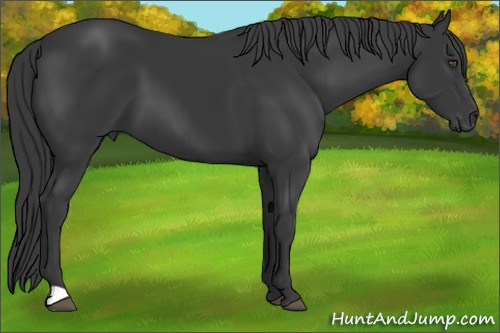
http://hj2.huntandjump.com/horse.php?horseid=297272
Banshee is an EE aa black horse. The basic genes that control base color are Extension (E or e) and Agouti (A+, A, At and a). Black horses will always have at least 1 dominant E at extension, giving the horse a black rather than a red (e) base and will be homozygous recessive (aa) for Agouti. If Banshee could be bred, all of his babies would be E_ a_. So they would all inherit a black base color from their dad but could inherit bay coloration (dominant agouti) from their mom.
-
Wild Bay

http://hj2.huntandjump.com/horse.php?horseid=300227
Wild Vines is a wild bay horse. He is Ee A+a. A+ is the gene for wild bay, the most dominant of the agouti genes. It will cover up A and At, the other two dominant forms of the gene. As you can see, Wild vines has quite minimal black markings on his legs, much less pronounced than on a normal bay or A_ horse.
Wild Bay is particularly affected by the darkening genes Ssty and DP (Dense Pheomelanin). I will give examples of these in a later post but if you click the search below you can see a variety of wild bay horses I own and how widely their color can change.
http://hj2.huntandjump.com/adv_search.php?status=any&ageg=&agel=&agee=&erag=&eral=&erae=&heightg=&heightl=&heighte=&boneg=&bonel=&bonee=&f_basic=none&f_adv=none&f_limit=25&stallion=1&mare=1&gelding=1&spayedmare=1&bty=1&lined=lined&foundation=1&name=&name_lm=like&color=&color_lm=like&owner=3790&owner_lm=like&breeder=&breeder_lm=like&sire=&sire_lm=like&dam=&dam_lm=like&barn=&barn_lm=like&pasture=&past_lm=like&tattoo=&tat_lm=like&tat_and=and&club=&bc_lm=like&bc_and=and&e1=&e2=1&a1=&a4=2&a2=2&a3=1&f1=&f2=&p1=&p2=&s1=&s2=&s3=&c1=&c2=&c3=&d1=&d2=&g1=&g2=&ch1=&ch2=&z1=&z2=&sa2=&sa1=&kit1=&kit2=&kit3=&kit4=&kit5=&kit6=&kit7=&kit11=&kit12=&kit8=&kit9=&kit10=&sp1=&sp2=&sp3=&pax31=&pax32=&rb1=&rb2=&o1=&o2=&l1=&l2=&ice1=&icei=&ice2=&ice3=&ice4=&ice5=&ice6=&ice7=&ice8=&brindle1=1&brindle2=1&wf1=1&wf2=1&wf3=1&wf4=1&wf5=1&wf6=1&offset=25&offset=0
-
Bay
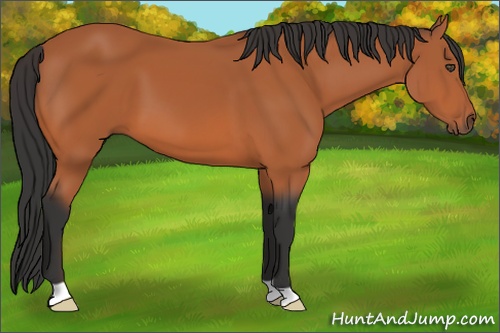
http://hj2.huntandjump.com/horse.php?horseid=293936
Padma Patil is a bright bay. She is eE AA with no sooty coloring to darken the red in her body coat. You can see how much higher the black markings come up her legs than Wild Vines.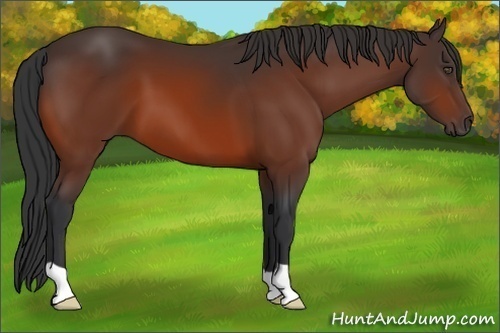
http://hj2.huntandjump.com/horse.php?horseid=297274
Hermione Granger (do you sense a name theme?) is a dark bay. She is Ee aA Ssty Ssty. The sooty darkening genes significantly darken her red body by mixing more black hairs into the coat. There is a little more variation to the regular Bay coloring than this, but I don't think it is as wide as the wild bay variation is.
This more familiar bay color is from the A agouti allele. It is overshadowed by the more dominant A+ but it is stronger than the brown At allele. So a horse that is E_ A+A will always be wild bay and a horse that is E _ AAt will always be plain bay. -
Brown

http://hj2.huntandjump.com/horse.php?horseid=324420
Rovers End is brown. She is Ee AtAt with no darkening sooty genes. As you can see, she is quite similar in color to Padma Patil.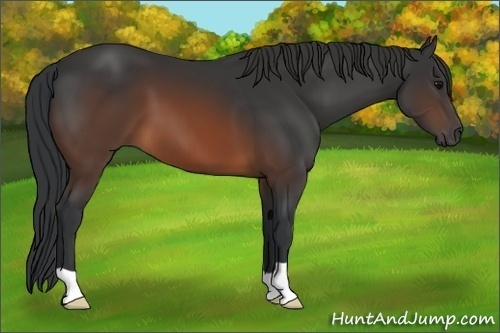
http://hj2.huntandjump.com/horse.php?horseid=347417
However, as you can see with Cheetah Wish, once you add any sooty to a brown colored horse, their color changes significantly. This girl is Ee Ata SstyS and has a much darker brown body overall with that reddish belly. This is a quite distinctive form of the brown color and is only more pronounced with more darkening genes present.
Brown At genes are only dominant over the recessive form of agouti, a. The other two dominant Agouti genes are more dominant than At. -
Chestnut
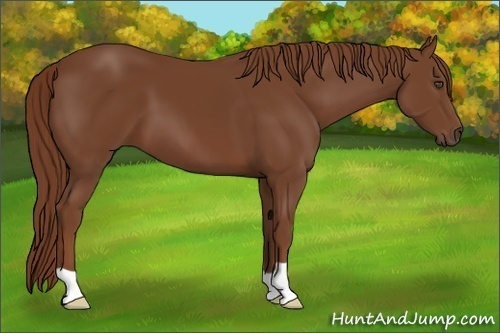
http://hj2.huntandjump.com/horse.php?horseid=297270
Minerva McGonogal is a chestnut. As you can see, she is recessive for Extension and her genes are ee aA. So she carries the Agouti gene for regular bay silently, but because she doesn't carry the gene for black coloration (dominant Extension or E) she can't express the bay.
Take home message? EE horses will ALWAYS have babies that are black based--black or agouti, no matter what color horse you breed them to (except Gray, which is the exception to every rule). ee horses will always have red based foals if you breed them to other ee horses, but if you breed them to a horse with an E gene, the foals may be red or black based. -
Just remember, that if you color test your horse, the gene sequence is clickable for individual genes, so you can click on them and it takes you to a page to help you learn about the gene. :)
-
Cream (Ccr) is a dilution gene that affects recessive Extension most obviously. It is difficult to impossible to see when heterozygous on a black horse, but homozygous cream will dilute a black coat visibly.
An incomplete dominant gene, heterozygous Ccr will dilute the coat less than homozygous Ccr. C is the symbol for no dilution. There is a third Cream allele--Cprl or pearl. I don't breed for that gene, so I hope someone who does can add information on it.
Palomino--Chestnut + CCr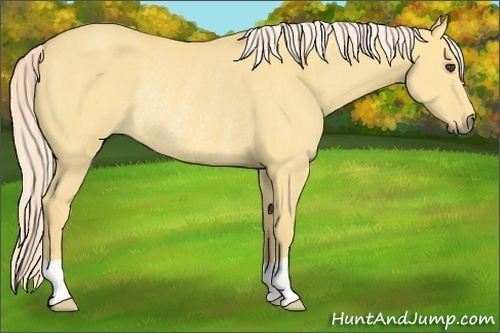
http://hj2.huntandjump.com/horse.php?horseid=328501
Touch of Charcoal (she got that name before she was born, and it never was changed *G*) is a non-sooty Palomino. You can see that she is the bright gold associated with palomino horses.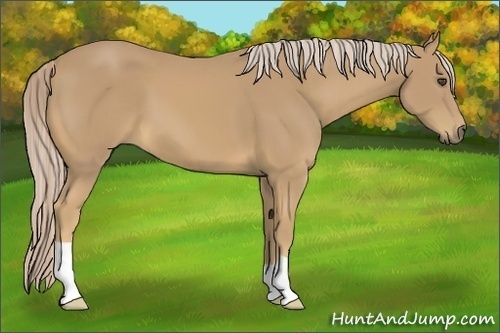
http://hj2.huntandjump.com/horse.php?horseid=328558
Lambent Klondike has a chestnut base coat (ee aa) with a single Cream gene added (CrC). She also carries heterozygous Sooty (SSty), which darkens her coat, and heterozygous Pangare (pP) which lightens her muzzle and the areas in front of her hind legs and behind her forelegs.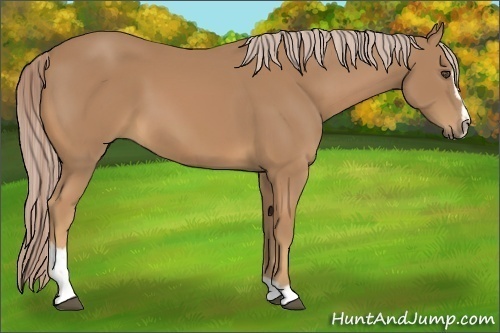
http://hj2.huntandjump.com/horse.php?horseid=332749
Sunswift Harmony is a homozygous Sooty Palomino. You can see that her coat is much darker than either of the other two.
Cremello--Chestnut with homozygous Cream CcrCcr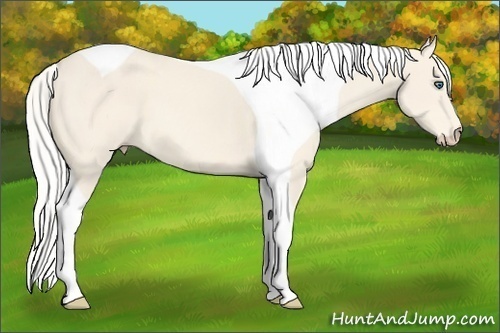
http://hj2.huntandjump.com/horse.php?horseid=267056
Mitye Capella is a non-sooty Cremello. It's hard to see, but her eyes are blue, a typical effect of homozygous Cream.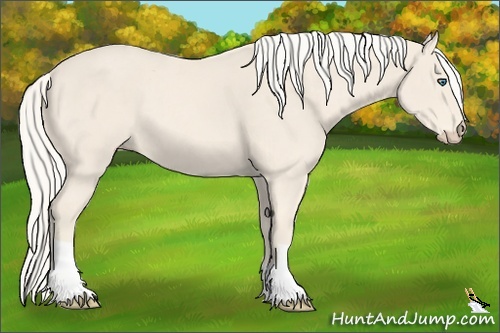
http://hj2.huntandjump.com/horse.php?horseid=389910
Masked Juniper demonstrates that Cream is such a dominant dilution gene that it overrides even homozygous Ssty almost completely.
De gustibus non disputandum. "There's no arguing about tastes."
SandyCreek Farm: ID# 441
also playing H&J1 as SandyCreek Acres: ID# 137592Thanked by 1Cheers -
Buckskin--Bay with Cream
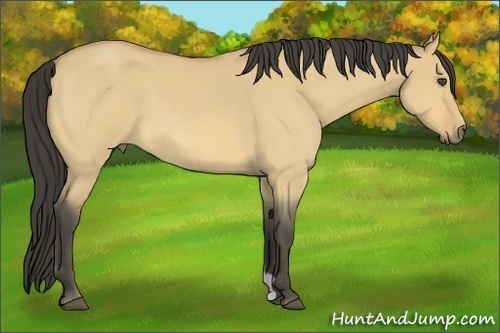
http://hj2.huntandjump.com/horse.php?horseid=270250
Trevannion is a non-sooty buckskin. He is Ee AA. He is also a roan, with minimal expression (very few white hairs).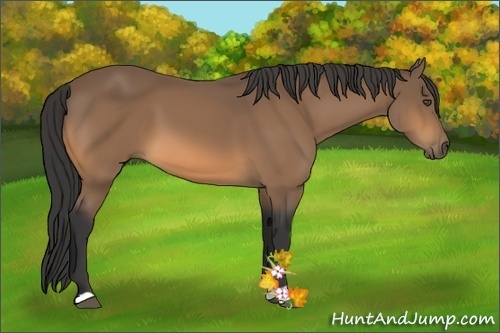
http://hj2.huntandjump.com/horse.php?horseid=286109
Diffendor is a buckskin with heterozygous Ssty.
As with the other colors, there can be considerable variations in the images.
Perlino--Bay with homozygous Cream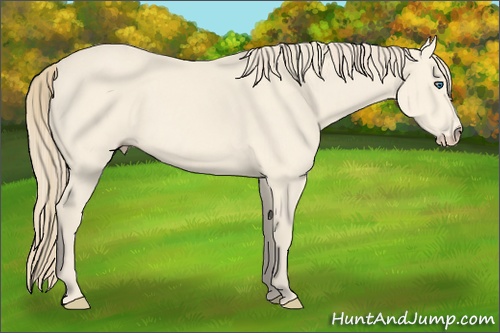
https://s3.amazonaws.com/kinetocore_hj2/horses/270266/270266.jpg?=7704
Torrigantur is a non-sooty Perlino. Once again, you will note the blue eyes.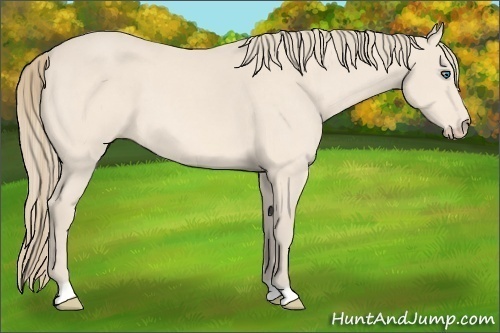
http://hj2.huntandjump.com/horse.php?horseid=258873
Chance of Toffee is homozygous Ssty and appears a bit darker than Torrigantur.
De gustibus non disputandum. "There's no arguing about tastes."
SandyCreek Farm: ID# 441
also playing H&J1 as SandyCreek Acres: ID# 137592 -
Cream on black coats. Cream has more trouble diluting black coats.
Smokey Black--Black with heterozygous Cream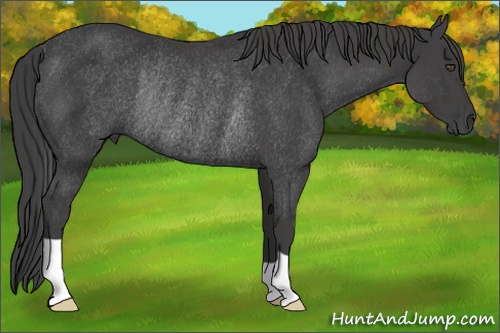
http://hj2.huntandjump.com/horse.php?horseid=267489
Song of the Snows is EE AA CCcr. As you can see, he appears to be black. The stripes of white roaning on his barrel are from the Rabicano pattern gene--RbRb, and not his Cream.
Smokey Creme--Black with Homozygous Cream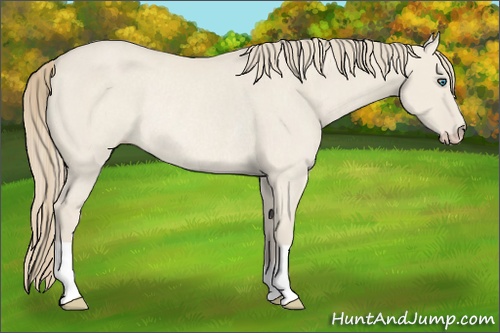
http://hj2.huntandjump.com/horse.php?horseid=267483
Shifting Ends is a Smokey Creme Dun, meaning she has the Dun gene as well as Cream. Her gene test reads
EE aa CcrCcr DD gg ff SSsty Pp Rbrb WF: Extensive. You can see that she also is heterozygous for Sooty, Pangare, and Rabicano, but they are all pretty much overwhelmed by the combination of Homozygous Cream and Homozygous Dun.
De gustibus non disputandum. "There's no arguing about tastes."
SandyCreek Farm: ID# 441
also playing H&J1 as SandyCreek Acres: ID# 137592 -
Dun is another dilution gene, not as strongly diluting as Cream, and effective on both red and black coats. It can also be found in combination with the other dilution genes--Cream, Silver, and Champagne. In real life Dun can frequently be seen by a dark stripe down the back bone and less frequently by a cross stripe over the withers. It also sometimes gives "Zebra stripes" on the legs. Here are some examples of dun on different coat colors.
Dun on Chestnut--Red Dum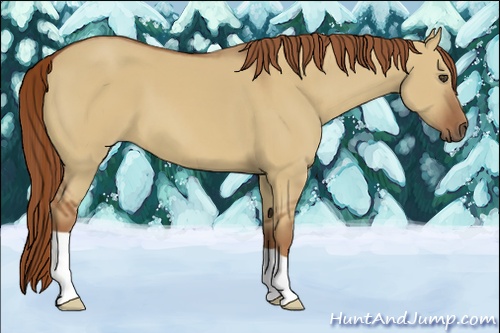
http://hj2.huntandjump.com/horse.php?horseid=309400
Touch the Bonfire is a red dun with heterozygous sooty. You can see her dorsal stripe as a darker brown line along her spine and her zebra stripes above her knees and hocks.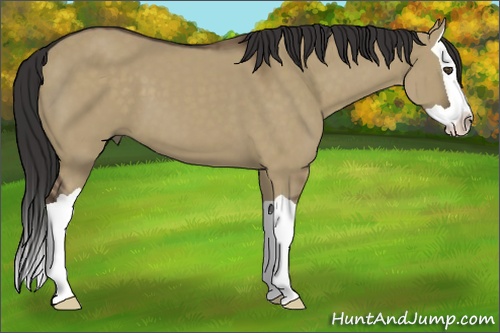
http://hj2.huntandjump.com/horse.php?horseid=289436
Xerxes is a Liver Red Dun, meaning he has homozygous Sooty and a copy of Dense Pheomelanin (DP), a non-testable gene that darkens red coats, although black horse can carry the gene without showing it, since they have no red hairs. You can clearly see his dorsal stripe, which gets noticeably thicker at the withers. He also has some Zebra striping, although his high white stockings hide most of it. Look at the back of his hind hock, just above the stocking to see the traces. One stripe shows slightly at the front of his right front leg, as well.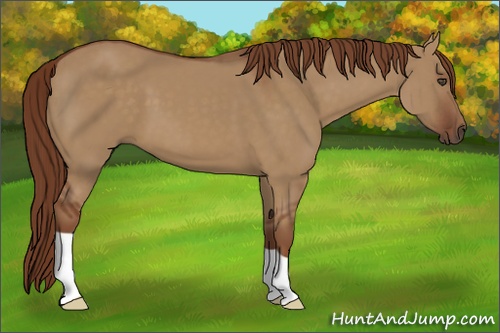
http://hj2.huntandjump.com/horse.php?horseid=288078
Rubanias is a homozygous Sooty Red Dun. Her dorsal and Zebra stripes are plain to see.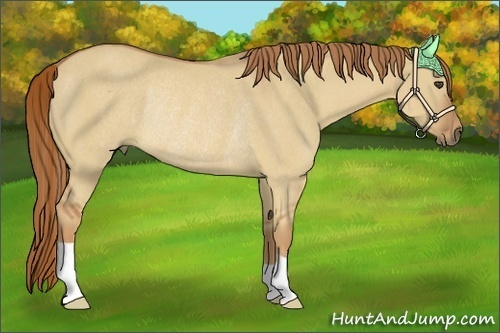
http://hj2.huntandjump.com/horse.php?horseid=309395
Modest Charm is a non-sooty red dun with Rabicano stripes on her barrel. She, too has both dorsal and zebra stripes. You may also have noticed that the lower legs and muzzles of Red Dun horses are darker than their body color.
Red Dun with Cream--Palomino Dun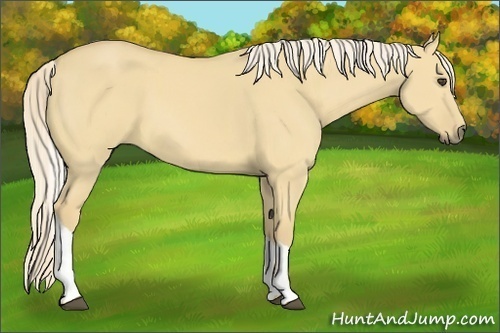
http://hj2.huntandjump.com/horse.php?horseid=334188
Sparkling Embrace is a non-sooty Palomino Dun. She has no apparent dorsal stripe, but there is just a hint of zebra stripes above her hock. The Cream gene appears to have diluted most of the dun markers. She is a bit darker than some non-sooty palominos, however.De gustibus non disputandum. "There's no arguing about tastes."
SandyCreek Farm: ID# 441
also playing H&J1 as SandyCreek Acres: ID# 137592 -
Bay Dun
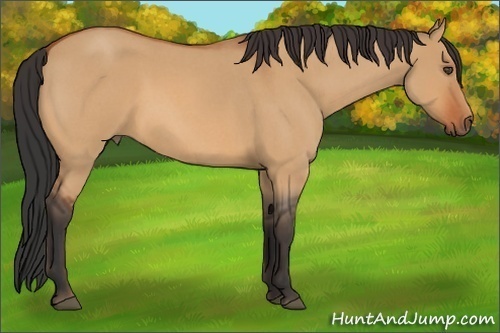
http://hj2.huntandjump.com/horse.php?horseid=270263
Murranitor is a bright, non-sooty bay dun. He displays the dorsal stripe with thickening at the withers, darker muzzle, and zebra stripes. Notice that his black stockings seem to lighten above the knee and hock, hinting that the dun's effect is definitely lessened below these joints.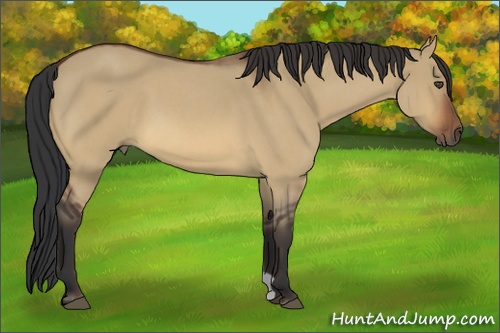
http://hj2.huntandjump.com/horse.php?horseid=270254
Prelandor is a heterozygous Sooty Bay Dun. He carries the typical dun markers and some lightening of his belly from his heterozygous Pangare. Note that the darker Dun muzzle overrides the Pangare lightening that normally would be there.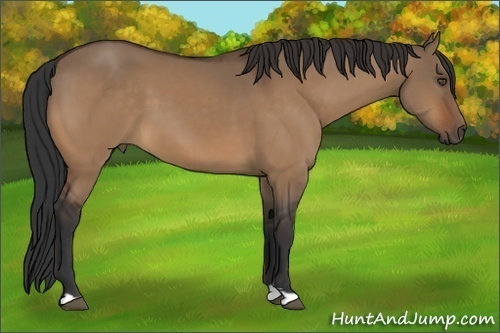
http://hj2.huntandjump.com/horse.php?horseid=270274
Posanus is a homozygous Sooty Bay Dun. You may have to look hard to spot his Dun markers.
Bay Dun with Cream--Buckskin Dun
http://hj2.huntandjump.com/horse.php?horseid=328580
Ginger Dreamer is a non-Sooty Buckskin Dun. He is also Wild Bay, which affects the coloring of his lower legs. Cream is masking the usual Dun markers, except that Dun appears to have dulled the gold of his body hairs.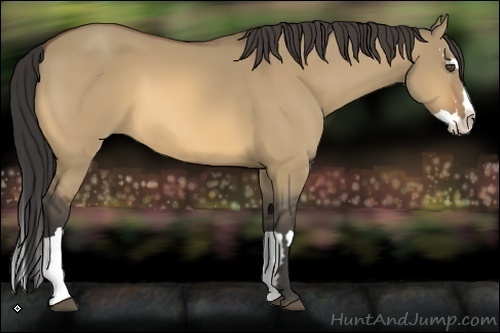
http://hj2.huntandjump.com/horse.php?horseid=270311
Chatty Pandora is a heterozygous Sooty Buckskin Dun.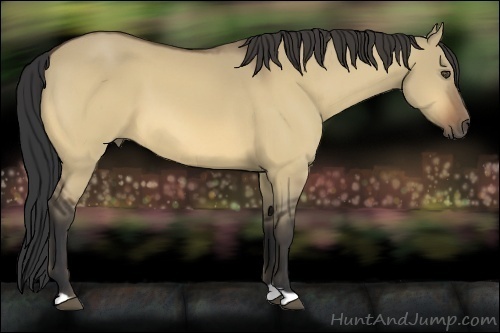
http://hj2.huntandjump.com/horse.php?horseid=320347
Sindoros is a homozygous Sooty Buckskin DunDe gustibus non disputandum. "There's no arguing about tastes."
SandyCreek Farm: ID# 441
also playing H&J1 as SandyCreek Acres: ID# 137592 -
Black with Dun--Grullo
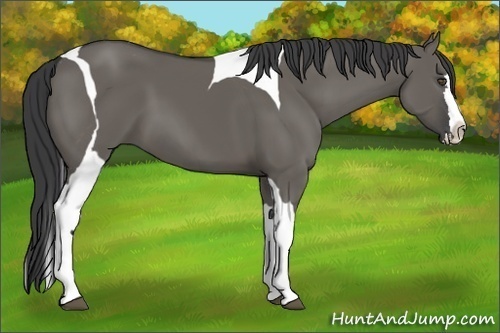
http://hj2.huntandjump.com/horse.php?horseid=300978
Liquid Fantasy is a non-Sooty Grullo. She displays the lightening that Dun causes with black hair. Her Tobiano markings mask most of the other dun markers.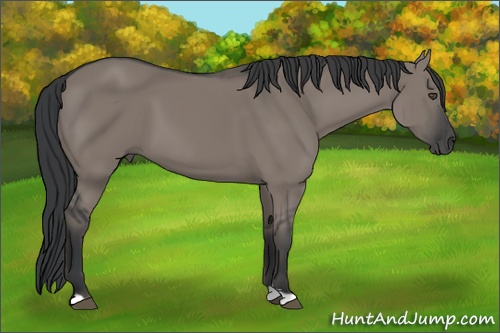
https://s3.amazonaws.com/kinetocore_hj2/horses/305250/305250.jpg?=5231
Repeated Current is also a non-Sooty Grullo. The dun markers are clearly present on her coat.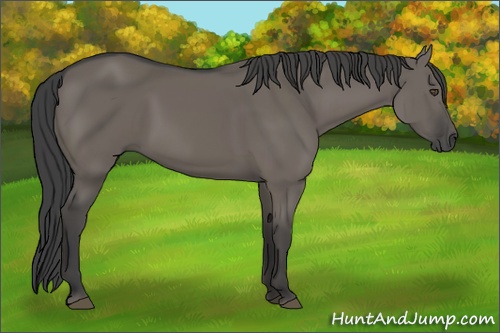
http://hj2.huntandjump.com/horse.php?horseid=328576
Tulip Dreams is a heterozygous Sooty Grullo. While Sooty generally is invisible on blacks, when a dilution gene is present, there can be some darkening. Note that the Dun markers are less visible than they were on Repeated Current.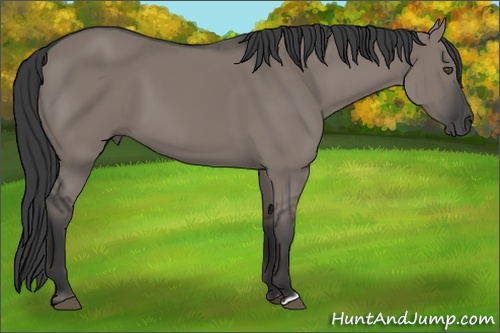
http://hj2.huntandjump.com/horse.php?horseid=270310
Diannus is a homozygous Sooty Grullo. His Dun markers are clearly visible. Notice that his gene test shows that he is homozygous recessive for Agouti, so, in spite of his black mane, tail, and lower legs, is definitely not a very, very dark Bay.
Black with Cream and Dun--Smokey Grullo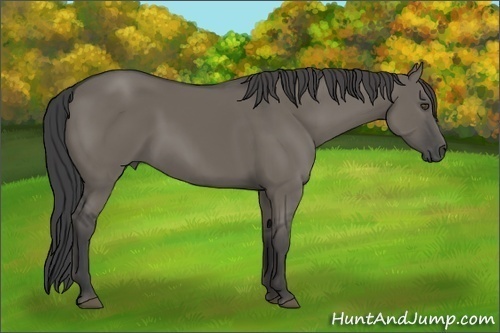
http://hj2.huntandjump.com/horse.php?horseid=286807
Castaway Dreamer is a non-Sooty Smokey Grullo. As with regular blacks, the heterozygous Cream has no diluting effects on the coat.De gustibus non disputandum. "There's no arguing about tastes."
SandyCreek Farm: ID# 441
also playing H&J1 as SandyCreek Acres: ID# 137592 -
Gray is a dominant gene that causes horses of all colors to lose pigment in their hair as they age. The effects vary as the horse ages. As foals they usually have lighter hairs around their eyes, the "goggle" effect. Many horses pass through a dapple gray stage, when their coats take on a mottled coloration. Eventually their coats become completely white, although the skin beneath the hair will remain black, except where patterned horses had pink skin beneath white the white patches of their pattern. This will be noticeable in real life, but not evident in the game. Homozygous Gray horses will gray out more rapidly than heterozygous Gray horses.
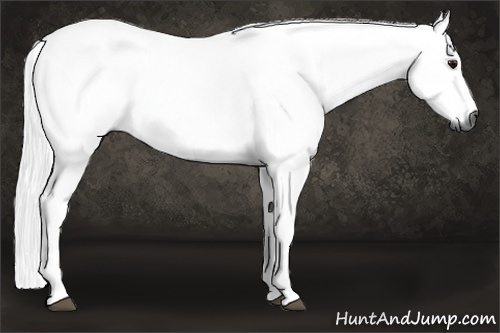
http://hj2.huntandjump.com/horse.php?horseid=498976
Mouse Troubles is a heterozygous Gray yearling. His base coat is homozygous Sooty Bay. He is carrying the At Brown gene, but that is overridden by being paired with dominant Agouti. As I am posting this at the end of the month, you can just see the goggle around his eye. The rest of his coat is quite markedly dappled.
http://hj2.huntandjump.com/horse.php?horseid=415953
Gentarial is a heterozygous Gray 5 year old. His base coat is non-Sooty Chestnut. His coat is dappled.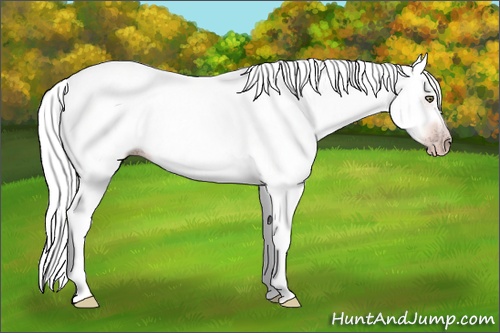
http://hj2.huntandjump.com/horse.php?horseid=393266
Sycharis is a heterozygous Gray 6 year old. Her base coat is non-Sooty Black.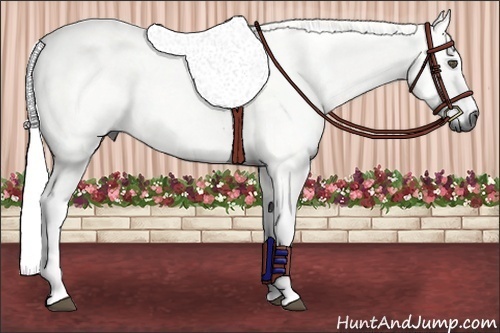
http://hj2.huntandjump.com/horse.php?horseid=368648
Miristandor is a heterozygous Gray 7 year old. His base coat is non-Sooty Chestnut.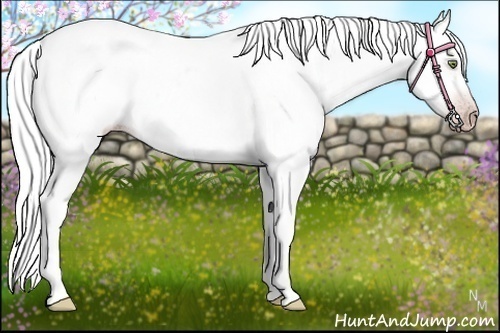
http://hj2.huntandjump.com/horse.php?horseid=368644
Day of Riches, for comparison, is a homozygous Gray 7 year old. Her coat has turned completely white. Her base coat is heterozygous Sooty Amber Champagne (bay with champagne) Dun Appaloosa. You can see the Appaloosa spotting on her pink muzzle.De gustibus non disputandum. "There's no arguing about tastes."
SandyCreek Farm: ID# 441
also playing H&J1 as SandyCreek Acres: ID# 137592Thanked by 1Cheers -
Dense Pheomelanin (DP); I have been asked to give you some examples of this gene, so here it is, a bit sooner than I'd planned on dealing with it.
This is a gene that cannot be tested using the Color Testing feature of the game. It causes red pigment pheolmelanin) in hair cells to multiply, making them much darker. It is easier to spot in Chestnut horses than it is in Bays, although the red body hairs of Bays can also be influenced by DP. Horses can be either heterozygous or homozygous for DP. Homozygous DP causes more darkening than heterozygous DP. When it is joined in Chestnut horses by Sooty, which causes black pigment in hair cells from the top down, Liver Chestnuts are produced. We have noticed the darkening effect of Sooty in the discussion of some of the dilution genes above.
So, horses can have up to four alleles of darkening genes--2 for Sooty and 2 for DP. It takes at least 3 darkening alleles to make a Liver Chestnut, 2 Sty and 1 DP or 1 Sty and 2 DP. Chestnuts and Palominos that are homozygous for both Sooty and DP appear black, and in real life are sometimes called Black Chestnuts or Palominos. In the game, however, we only have a special name for the Chestnuts with 3 or 4 darkening alleles--Liver Chestnuts.
http://hj2.huntandjump.com/horse.php?horseid=351229
KZ Finalized is a Liver Chestnut with homozygous Sooty. His coat is a smooth, even dark chocolate brown. This means that he is heterozygous for DP, giving him 3 darkening alleles. Because he is homozygous recessive for Pangare, there is no lightening of the hairs on his muzzle and belly.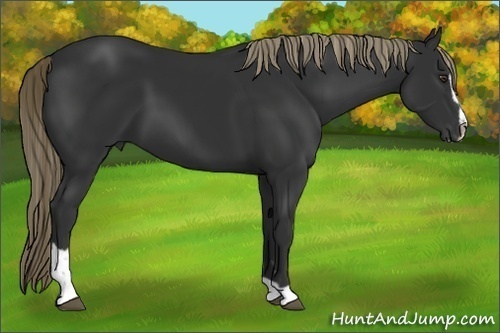
http://hj2.huntandjump.com/horse.php?horseid=343932
Exchange the Light is, despite his appearance, a Liver Chestnut horse. His genetic test returned ee AA, which proves that he is Chestnut. He is homozygous for sooty, so the fact that he appears black confirms that he is also homozygous for DP.
http://hj2.huntandjump.com/horse.php?horseid=368629
Dreliarist is a Liver Chestnut with heterozygous Pangare. He is homozygous Sooty and heterozygous DP.
Palominos with 3 darkening Alleles are sometimes called Chocolate Palominos.
http://hj2.huntandjump.com/horse.php?horseid=204198
Cuyamaca Fog is a Chocolate Palomino. She is homozygous for Sooty, and heterozygous for DP.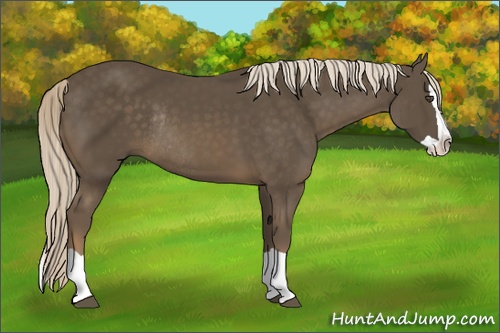
http://hj2.huntandjump.com/horse.php?horseid=380033
Sampon Jalava is listed as a Chocolate Palomino. He is homozygous Sooty, and appears dark brown. However, since he is noticeabley darker than his Chocolate Palomino dam, he may have a copy of DP from her and a copy of DP from his Liver Chestnut sire as well.
De gustibus non disputandum. "There's no arguing about tastes."
SandyCreek Farm: ID# 441
also playing H&J1 as SandyCreek Acres: ID# 137592Thanked by 1ConfluenceFarms -
DP also affects bay, brown and wild bay, but is harder to detect because it doesn't change the color name and they cannot be registered in the Liver breeders club. Here are a few examples of DP with each of the three Agouti genes to give you a feel for how much it can change them. I personally am a HUGE fan of DP with bay, brown and wild bay.
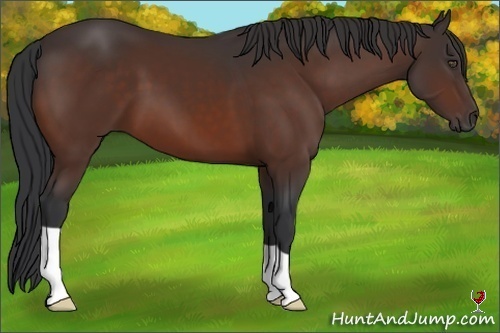
http://hj2.huntandjump.com/horse.php?horseid=310478
So Rural Aspen here is a homozygous sooty, heterozygous DP bay. Her dad was a plain dark bay and her mom was a liver red dun.
http://hj2.huntandjump.com/horse.php?horseid=366100
By contrast, Freak Queen is a homozygous sooty homozygous DP bay. Her mom and dad are both also homozygous for sooty and DP. I happen to know this because I paid to put the DP on her dad and her mom is from a herd helper (Freaky Friday, which comes out every Friday the 13th) that is also known to be homozygous DP (even though her mom is black and you can't see DP on black because they don't have any red pigment). You can see how much richer Freak Queen's color is than Rural Aspen.
http://hj2.huntandjump.com/horse.php?horseid=467258
Rioja Wind is heterozygous for DP and has no sooty, so you can see that his body is quite flame red with the black points. Wild bays have a similar flame or blood red coloring with DP.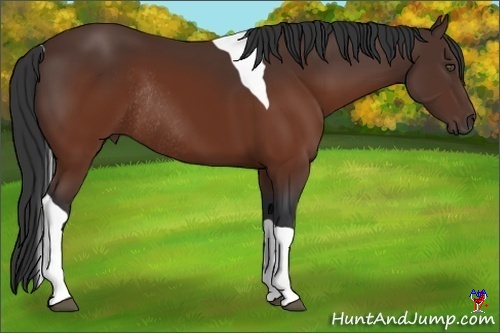
http://hj2.huntandjump.com/horse.php?horseid=366437
Dance Off is homozygous for sooty, heterozygous for DP and homozygous for brown. He looks much more like a plain bay than most homozygous Browns do. He gets his DP from his mom, who is darker chestnut than would be normal for a heterozygous sooty chestnut.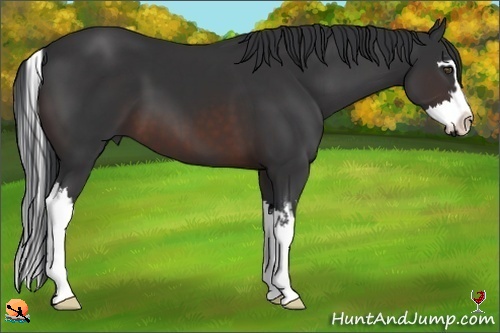
http://hj2.huntandjump.com/horse.php?horseid=342654
For emphasis, here is a heterozygous brown boy who is also homozygous for sooty and probably het for DP. You can see how much more of his coat is black, and how that normally reddish belly is almost mahogany brown. He has DP on both his mom and dad's side, so he may actually be homozygous for it.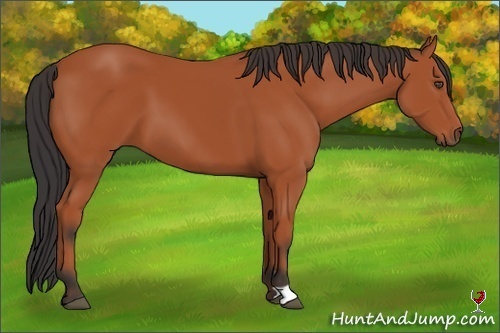
http://hj2.huntandjump.com/horse.php?horseid=467244
Rioja Spaces is probably heterozygous for DP and has no sooty. He had a richer red to his coat than a wild bay with no DP, who can appear somewhat tan colored.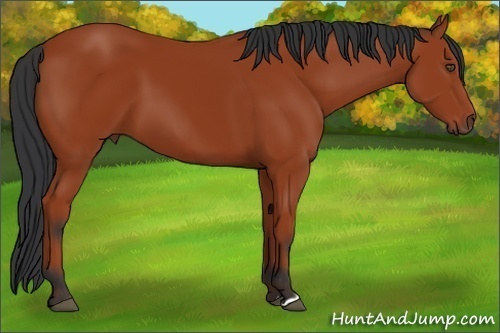
http://hj2.huntandjump.com/horse.php?horseid=366108
Rioja Prince, his father, is heterozygous for sooty and DP. He is redder than Rioja Spaces.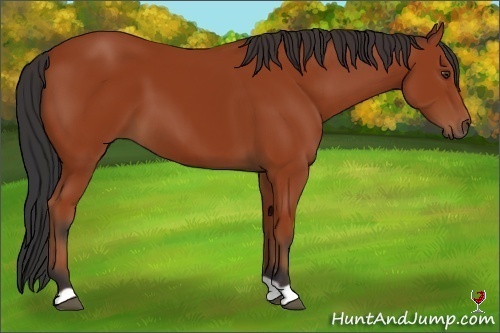
http://hj2.huntandjump.com/horse.php?horseid=467275
Grassy Princess is reddest of all, with homozygous sooty and heterozygous DP. She is actually quite similar in coloring to Rioja Wind, the brigh DP plain bay above.Thanked by 1SandycreekFarm














